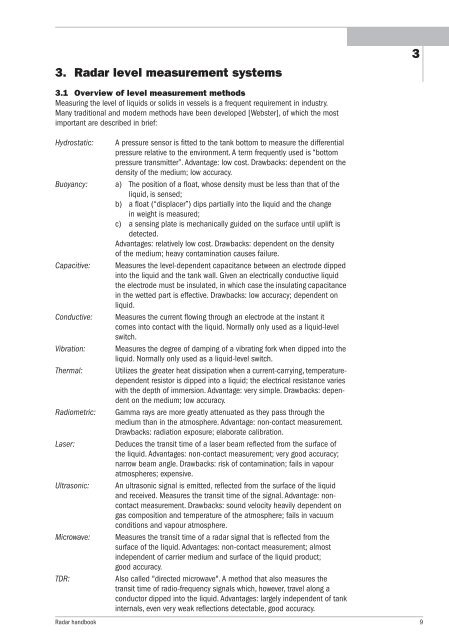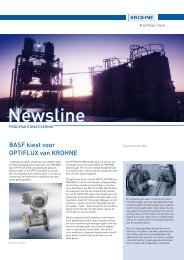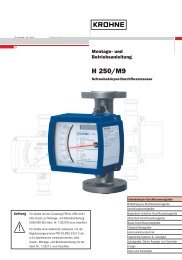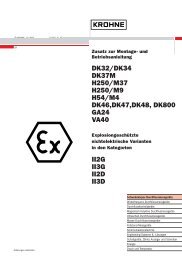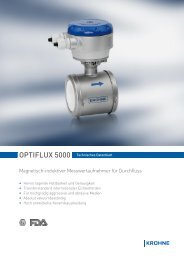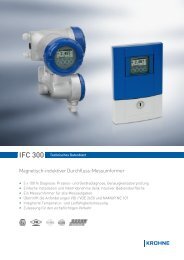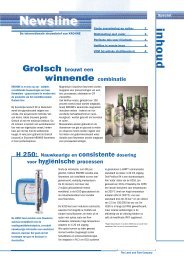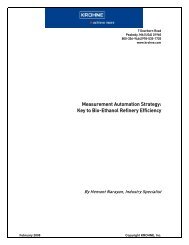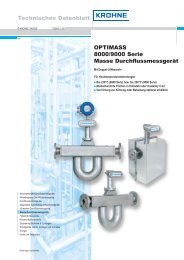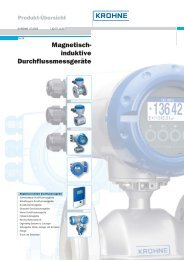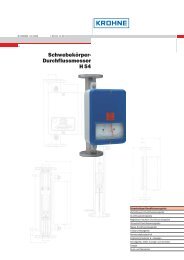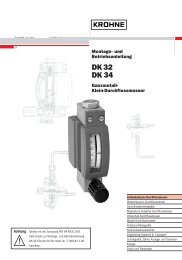Radar Technology for Level Gauging - Krohne
Radar Technology for Level Gauging - Krohne
Radar Technology for Level Gauging - Krohne
You also want an ePaper? Increase the reach of your titles
YUMPU automatically turns print PDFs into web optimized ePapers that Google loves.
3. <strong>Radar</strong> level measurement systems<br />
3.1 Overview of level measurement methods<br />
Measuring the level of liquids or solids in vessels is a frequent requirement in industry.<br />
Many traditional and modern methods have been developed [Webster], of which the most<br />
important are described in brief:<br />
Hydrostatic: A pressure sensor is fitted to the tank bottom to measure the differential<br />
pressure relative to the environment. A term frequently used is “bottom<br />
pressure transmitter”. Advantage: low cost. Drawbacks: dependent on the<br />
density of the medium; low accuracy.<br />
Buoyancy: a) The position of a float, whose density must be less than that of the<br />
liquid, is sensed;<br />
b) a float (“displacer”) dips partially into the liquid and the change<br />
in weight is measured;<br />
c) a sensing plate is mechanically guided on the surface until uplift is<br />
detected.<br />
Advantages: relatively low cost. Drawbacks: dependent on the density<br />
of the medium; heavy contamination causes failure.<br />
Capacitive: Measures the level-dependent capacitance between an electrode dipped<br />
into the liquid and the tank wall. Given an electrically conductive liquid<br />
the electrode must be insulated, in which case the insulating capacitance<br />
in the wetted part is effective. Drawbacks: low accuracy; dependent on<br />
liquid.<br />
Conductive: Measures the current flowing through an electrode at the instant it<br />
comes into contact with the liquid. Normally only used as a liquid-level<br />
switch.<br />
Vibration: Measures the degree of damping of a vibrating <strong>for</strong>k when dipped into the<br />
liquid. Normally only used as a liquid-level switch.<br />
Thermal: Utilizes the greater heat dissipation when a current-carrying, temperaturedependent<br />
resistor is dipped into a liquid; the electrical resistance varies<br />
with the depth of immersion. Advantage: very simple. Drawbacks: dependent<br />
on the medium; low accuracy.<br />
Radiometric: Gamma rays are more greatly attenuated as they pass through the<br />
medium than in the atmosphere. Advantage: non-contact measurement.<br />
Drawbacks: radiation exposure; elaborate calibration.<br />
Laser: Deduces the transit time of a laser beam reflected from the surface of<br />
the liquid. Advantages: non-contact measurement; very good accuracy;<br />
narrow beam angle. Drawbacks: risk of contamination; fails in vapour<br />
atmospheres; expensive.<br />
Ultrasonic: An ultrasonic signal is emitted, reflected from the surface of the liquid<br />
and received. Measures the transit time of the signal. Advantage: noncontact<br />
measurement. Drawbacks: sound velocity heavily dependent on<br />
gas composition and temperature of the atmosphere; fails in vacuum<br />
conditions and vapour atmosphere.<br />
Microwave: Measures the transit time of a radar signal that is reflected from the<br />
surface of the liquid. Advantages: non-contact measurement; almost<br />
independent of carrier medium and surface of the liquid product;<br />
good accuracy.<br />
TDR: Also called "directed microwave". A method that also measures the<br />
transit time of radio-frequency signals which, however, travel along a<br />
conductor dipped into the liquid. Advantages: largely independent of tank<br />
internals, even very weak reflections detectable, good accuracy.<br />
<strong>Radar</strong> handbook 9<br />
3


